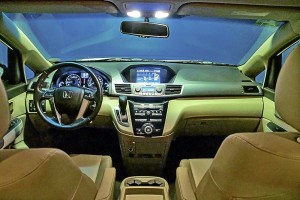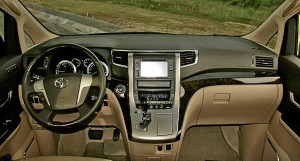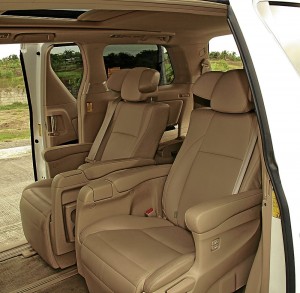While I love supercars, sports cars, tuner cars and purpose-built track-only performance cars, I have to admit that it is quite tiring to drive one. It feels good to be inside a low-slung cockpit but it’s a real pain in the arse to get in and out. The equally low-slung ride-height makes clearing ramps, humps and steep driveways a real agonizing experience as these cars’ low front bumpers, chin spoilers and/or diffusers will scrape themselves against the cold hard concrete or asphalt, then do so again when the long-wheelbase chassis’ middle section scrapes itself.
A minivan, more than a comfortable executive luxury car provides the antithesis, the exact-opposite experience to the aforementioned cars.
Most notable of which is the size: Most minivans nowadays have a simple 2-box design that is designed to house multiple (7 or more in the case of the Alphard and Odyssey) passengers, whereas most proper sports and supercars, even if they have two seats, are actually only optimized to perform at their best with a single occupant, that is the driver, on-board.
A minivan also has that quasi-SUV seating position: up high, with a commanding view of the road ahead, having little concern for the surface imperfections ahead, save for bothering
your passengers who have probably fallen asleep. While both minivans trace their roots to the American car culture, their intended areas of use could not have been farther from each other.
The Toyota Alphard has been a success since Toyota introduced it to premium RHD markets in Asia (Japan, Singapore, Thailand and Hong Kong to name a few). The tall roof is exacerbated by the narrow width, designed to fit in narrow Asian streets. It is supremely luxurious, boasting of Ottoman seats for the middle row which recline, retract and slide fore and aft to increase legroom for the middle-row passengers.
Seven airbags keep occupants safe, with dual front, dual front seat side and dual curtain airbags surround the occupants. An additional knee airbag protects the driver further. The entire interior is covered in Toyota’s trademark beige leather.
The steering wheel, lifted from a previous model Toyota Camry, adjusts for reach and rake, and is surprisingly responsive and quick, if not exactly delivering telepathic levels of steering feel. This is fine because the Alphard’s steering should focus on comfort and refinement rather than absolute performance. The instrument cluster has classy machined-aluminum bezels with clearly written numbers for speed and engine RPM, mimicking that of an expensive military-style chronograph.
Power comes from the familiar 2GR-FE 4-cam 24-valve 3.5L V6 engine also found in the Camry, producing 271 HP and 340 Nm of torque. It is partnered with a 6-speed ECT computer-controlled automatic transmission powering the front wheels.
To reduce chances of torque steer and losing control, the Alphard is fitted with a vehicle dynamics control or VDC which acts as both traction and stability control, working in tandem with the ABS-EBD equipped 4-wheel disc brakes and engine ECU to regulate power, keep all four wheels rotating at the same rate and ensure better driver control.
All told, it weighs in at a hefty 1,950 kg for the V6 model. The Nano-E air conditioning filtration system keeps the air inside the cabin ionized and well-filtered so nobody starts snoring due to a clogged nose when they fall asleep inside the Alphard. It’s also got HID headlamps, LED tail lamps, plus power operation for the two side doors with antijam protection as well as power operation for the rear lift-gate, which can be controlled by buttons near the driver, or by the regular door handles themselves on each respective door.
The 216/65R16 all-season touring tires provide comfort with sure-footed stability. In Japan, you’ll see Alphards running bling-sized 20-inch wheels slammed to the ground, with wild
THE ODYSSEY is lower, allowing slightly easier entry and exit for passengers particularly in the third row.
engine upgrades and even wilder body kits, while the inside is usually transformed into a love shack complete with disco lights and a booming audio/video system. Quite a techno-fest, even in tuned form, but Honda’s offering means the two titans are evenly matched.
Honda’s Odyssey is pure American. It’s made in America, for the American market. Size-wise, the Odyssey is lower, allowing slightly easier entry and exit for passengers particularly in the third row, and it is powered by a 3.5L V6 as seen in Honda’s Odyssey and Accord V6 executive sedans. Focus has been given on low-end torque, with the Odyssey putting out 247 HP and 343 Nm of torque but attached to a 5-speed automatic powering the front wheels, one less than the Alphard.
It has eight airbags, one better than the Alphard, providing a knee bag for both the driver and front passenger. Power-operated side doors and lift-gate also come as standard, and the Odyssey also has its own Vehicle Stability Assist System (traction/stability control) as well as ABS-EBD brakes. One crucial difference is that the Odyssey has a proper rearview-facing reverse camera which displays the Odyssey’s posterior on an 8-inch LCD high resolution monitor; it really aids in parking, working in tandem with a sonar system to help you make sure you slot the Odyssey in the tightest, smallest possible space it can fit in, while the Alphard only utilizes a sonar system to aid in parking. And while the Alphard utilizes a narrow track width to allow it to fit into the smallest spaces, the Odyssey fights back with a ridiculously small (for a minivan) turning radius of 5.4 meters versus the Alphard’s 5.7 meters to allow it to maneuver in small, cramped spaces.
The interior is very ‘homely American’ with some traces of Japanese Zen minimalism, as opposed to the Alphard’s high-tech/anime-like futuristic Japanese theme. It comes with an 8-seater ability, one better than the Alphard, and comes with tilt and telescopic adjustment for the steering wheel, which, though probably not as important, does offer significantly better levels of feel and feedback, perhaps a nod to Honda’s sporting background despite building a car for the family.
The sportiness can be seen by the low drag roofline and bigger 17-inch wheels carrying wider and chunkier 235/65R17 all-season touring tires, with firm-feeling brakes that offer more consistent pedal feel and modulation. While it might not boast of the Ottoman seats of the Alphard, the Odyssey’s second and third row seats fold completely flat to the floor, which allows easy loading up of big and bulky objects, making the Odyssey surprisingly more versatile than the Alphard in this regard.
THE ALPHARD’S tall roof is exacerbated by the narrow width, designed to fit in narrow Asian streets.
The crucial question is, which is better to drive? Admittedly, I tried the vehicles on separate days, and in separate locales, the Alphard in the tight city streets of Metro Manila, the Odyssey on the wide-open roads in Northern Luzon. I did a short drive of both vans in their respective opposite locales as well, but for a shorter period of time. The Alphard impresses with its refinement conquering poorly paved city roads while the Odyssey lapped up the sweeping northern highways with aplomb. Both deliver surprisingly good driving dynamics, minivan or not, and both vehicles capably cocoon in comfort their occupants. But there is no clear winner here as both are close, being far more capable than the sum of their respective parts. It all boils down to preference.
I like the Alpahrd’s anime-futuristic interior, but the swooping roofline of the Odyssey just seems more ‘sporty’ as minivans go. I like the Alphard’s sliding seats, but really hanker for the Odyssey’s fold-flat seats because I haul a lot of junk, mostly car parts, so I appreciate a big cavernous interior.
The Odyssey’s engine seems to have better low-end response and torque, but the Alphard’s V6 has more impressive high-end pull. Both competitors evenly matched, trading blows and receiving them with equal measures of gusto and enthusiasm. In hindsight, the Filipino market is lucky to have two supremely capable, enjoyable, and dare I say it, fun-to-drive minivans.
About the only thing both minivans are dead-even on is fuel consumption: Both returned a miserly 5.6 km/liter in city driving, and a fairly acceptable 7.8 km/liter out on the open road.
And the winner? You, the buyer of either minivan.




